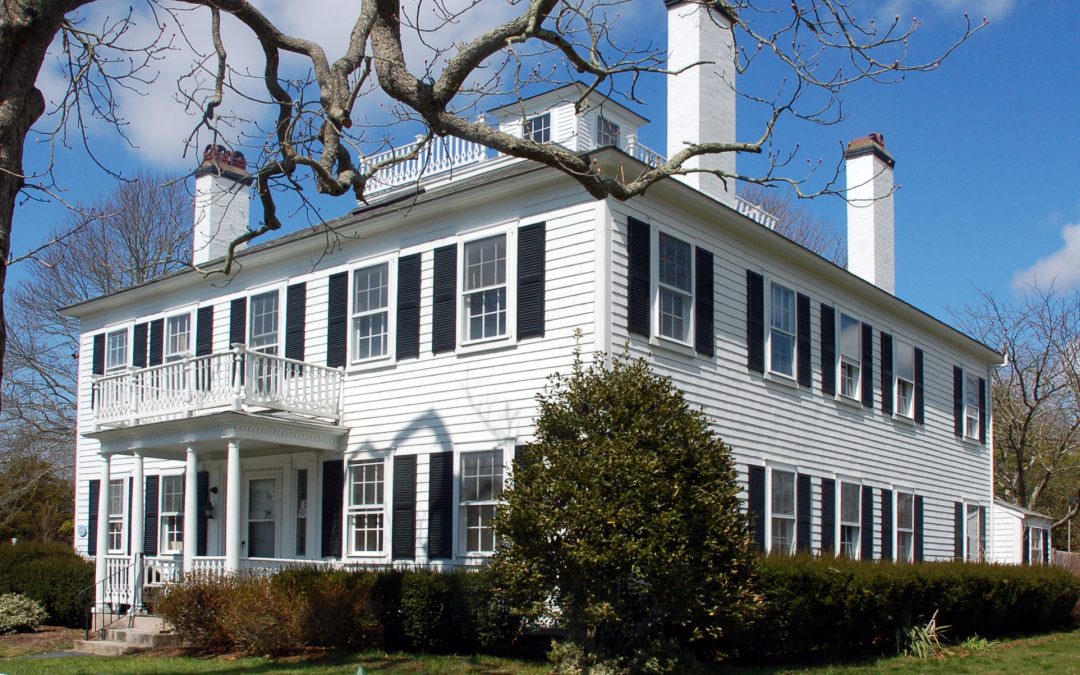By SAM DRYSDALE Just as the sea shapes the Cape Cod landscape, the sea captains who once made this peninsula their home shaped the industry and architecture of the region. Houses originally built for 19th century mariners still stand across the Upper Cape in towns that were no more than small villages at the time of their erection—windows through which to view the Upper Cape’s proud maritime history. Captain William Bodfish — 54 Main Street, Falmouth
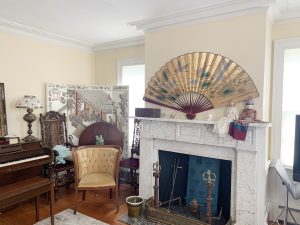
SAM DRYSDALE/ENTERPRISE
The interior of the Captain William Bodfish House. The staircase has wave embellishments carved into the wood and the stair rail is likely made of an old ship mast.
Captain William Bodfish was the youngest master-class sea captain on Cape Cod in 1814 when he decided to build the prominent house at the entrance to the Falmouth Village Green. Just 21 years old and newly married, the sea captain was making a name and fortune for himself trading goods between Europe and the United States. Capt. Bodfish wanted his house to signify his growing importance, so he built it about 30 feet into Main Street, which now results in the curve from Palmer Avenue to Main Street near the village green. Capt. Bodfish’s first wife, Deborah, died in childbirth within a year of moving into the house, leaving the captain with a son and a large home and no one to take care of them while he was off at sea. According to local legend, Mr. Bodfish married a woman named Mary Cotter at the church next door to his house. He took her on a horse and buggy ride around the village green, dropped her off at his house on Main Street and kept riding to Woods Hole to catch the tide for a half-year stint at sea. The three-story federal-style house has a widow’s walk, gable-front orientation and two prominent chimneys. Inside the house, details such as a wave-patterned engraved staircase and a stair rail likely made of an old mast hint at the original owner’s prowess on the high seas. An authentic Italian marble fireplace brought back from a voyage was unique to the area at the time, and townsfolk would visit the house just to see it. Now, still, the fireplace is worth about $40,000.
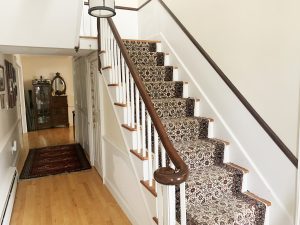
SAM DRYSDALE/ENTERPRISE
The parlor of the Captain William Bodfish House on Main Street in Falmouth. The current residents try to recreate how the captain might have decorated when he lived there, with goods from Eastern Asian adorning the walls. Capt. Bodfish brought the Italian marble fireplace back to Falmouth from one of his voyages.
The 54 Main Street property is currently owned by the First Congregational Church of Falmouth. After Capt. Bodfish died at the young age of 31, his wife sold the house to the then-prominent Swift family, who owned the property until the 1960s. The church bought the home as a parsonage from the Swift family. Four families have lived in it since, including the current residents, the Reverend Jonathan Drury, his wife, sons and three rescue dogs. While some parts of the house have been updated, such as the kitchen and bathrooms, Mr. Drury and his family have done their best to preserve the historical integrity of the house. Mr. Drury used to frequent the Sandwich Auction House to purchase decorations similar to the goods Capt. Bodfish might have brought back from his voyages. Additionally, Mr. Drury claims that before he leaves the house, he is dedicated to reviving a 25-foot-deep freshwater well covered by the floorboards of 54 Main Street, what he calls “a very cool piece of local history.” He plans to make a window on the floor to look into the well—even if he has to go into the floorboards with a hammer himself. “I don’t have the skills required, but I have the will,” he said. “But, if that’s what it takes, it needs to be shared.” Captain Ezra Nye House — 152 Main Street, Sandwich
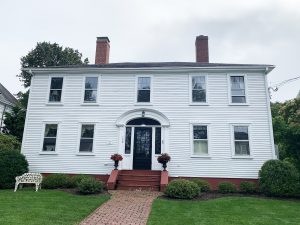
SAM DRYSDALE/ENTERPRISE
Exterior of the Captain Ezra Nye house, on Main Street in Sandwich.
Settled comfortably on a yard of green grass with a footpath leading out to Main Street in Sandwich, the Captain Ezra Nye House is a standing reminder of the town’s accomplishments on the sea. The symmetrical federal-style house has been home to the most celebrated sea captain in Sandwich’s history, innkeepers and inn guests, a retired couple and, as some would believe, a ghost. Capt. Ezra Nye had the house built in 1828, as he was establishing himself as a sea captain of distinction, according to documents from the Nye Museum in East Sandwich. In 1829 Mr. Nye drove a liner from Liverpool to Boston in 20 days. Seven years later in 1836, he sailed his ship, The Independence, round-trip between New York and London in 34 days. This voyage held the record for the fastest time on the eastward passage for 20 years. In addition to his reputation for efficiency and speed, Capt. Nye was distinguished by the contents of his shipments. He carried the US presidents’ messages to England for many years.
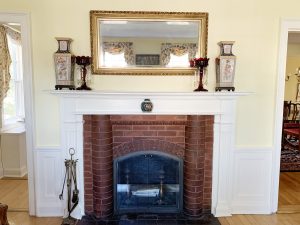
SAM DRYSDALE/ENTERPRISE
An original fireplace in the Captain Ezra Nye House on Main Street in Sandwich.
The sea captain is perhaps most famous for his harrowing rescue of the British ship Jessie Stephens, for which he was rewarded with a medal and gold chronometer from Queen Victoria. Though Capt. Nye originally had the house built because he had outgrown his smaller dwelling across the street, he only lived at 152 Main Street for three years.
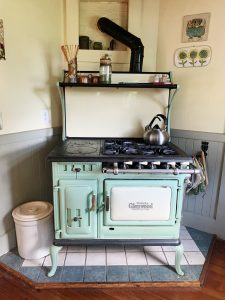
SAM DRYSDALE/ENTERPRISE
An 100-year-old Glenwood oven in the kitchen of the Captain Ellis Swift house. The current homeowner still uses the stove and oven every day.
The house changed hands several times over a century and a half before becoming an inn in the 1980s. Today it is owned by a retired couple who have pursued major renovations to the house and returned it to a single-family home. The current owners added a section to the back, modernized the kitchen, bedrooms and bathrooms, and built a porch. Some details in the house, however, remain the same. The living room fireplace is original, and a painting of the Independence hangs in the parlor. Some even say the history comes alive at night. One guest at the Nye House, when it was still a bed and breakfast, swore that an invisible someone—or something—sat on the edge of his bed one night and loudly shook off their boots. Other guests reported feeling “ghostly breezes” and scraping noises. The current owner said during the renovation one construction worker swore he saw a man in the attic. Interestingly, a relic of Capt. Nye can still be found today—the sea captain’s chalk signature on a wooden plank not far from the alleged sighting. Captain Ellis Swift House — 59 Sandwich Road, Bourne
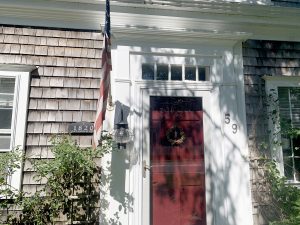
SAM DRYSDALE/ENTERPRISE
Exterior of the Captain Ellis Swift house on Sandwich Road in Bourne. The house is in the Cape Cod style and sits on a plot of land right next to the canal.
The Swifts were one of the oldest and most prominent families on the Upper Cape, a dynasty of town leaders, sea captains and industrialists who made Bourne their home. Captain Ellis M. Swift built his house in Bourne Village, then called West Sandwich, around 1820. It is a Cape Cod-style house on a large plot of land close to the Cape Cod Canal. At the time of the house’s construction, the canal was only a mere river with a footpath across it. Keene Street was then called Bridge Street, and Capt. Swift’s house sat at one end of it. Given its position at one end of the bridge, the sea captain’s house was used as an economic hub throughout the 19th century. First there was a small shop for groceries and medicines attached to the house. Later, a barber shop might have sprung up, and what is now used as a bathroom was at one point a telephone room. Inside, there is evidence of the original owner’s wealth. Authentic Sandwich glass is in the windows, hand-carved woodwork molding lines the ceilings and fireplaces, and textured wallpaper still adorns parts of the house. There is evidence not only of Capt. Swift’s fortune but also of his character. The house has uniquely wide wooden panels on the floor of one room. This wood paneling was very rare at the time, as it had to come from an especially large tree. According to the current owner of the house, it was said that only the king could have such floors, so, to spite the king, Capt. Swift installed 18-inch wood panels. The house was passed from Capt. Swift to Ordello Swift, then to Ordello’s son Thorton and Thornton’s wife, Alyce. Thorton fought in World War I before becoming the third consecutive Swift to be appointed postmaster for the Town of Bourne, continuing the family’s long history of town leadership. Today, a retiree with a long-haired gray cat happily resides in the 2,268-square-foot house. The homeowner bought the property in 2016 because of a love of homes with character, warmth, charm, history…and dust.

